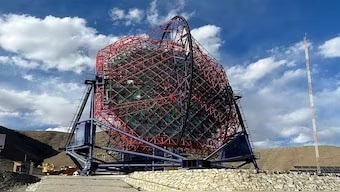
In a groundbreaking advancement for space research, India has inaugurated the world’s highest imaging Cherenkov telescope, known as the Major Atmospheric Cherenkov Experiment (MACE) observatory. Situated at a staggering altitude of over 4,300 meters in Hanle, this sophisticated facility is set to revolutionize the study of cosmic rays and high-energy astrophysics, opening new horizons for Indian science.
The observatory is designed to probe deep cosmic phenomena, including supernovae, black holes, and gamma-ray bursts. As part of global efforts in multimessenger astronomy, MACE is expected to elevate India’s contributions to the international scientific community.
Dr. Ajit Kumar Mohanty, Secretary of the Department of Atomic Energy (DAE) and Chairman of the Atomic Energy Commission, officially inaugurated the observatory. The ceremony coincided with the DAE’s Platinum Jubilee celebrations, underscoring the observatory’s pivotal role in advancing India’s scientific pursuits. Dr. Mohanty emphasized that the MACE telescope will not only boost India’s capabilities in high-energy astrophysics but will also foster collaborations with leading research institutions worldwide.
Developed by the Bhabha Atomic Research Centre (BARC), with assistance from the Electronics Corporation of India Limited and other industry partners, the MACE observatory holds the distinction of being Asia’s largest imaging Cherenkov telescope. Dr. S. M. Yusuf, Director of the Physics Group at BARC, noted that this telescope stands as a testament to India’s expertise in indigenous engineering and will significantly advance research in space science and cosmic-ray detection.
The inauguration of MACE signals India’s ambition to be at the forefront of space research, paving the way for new discoveries in the realm of high-energy cosmic events.










